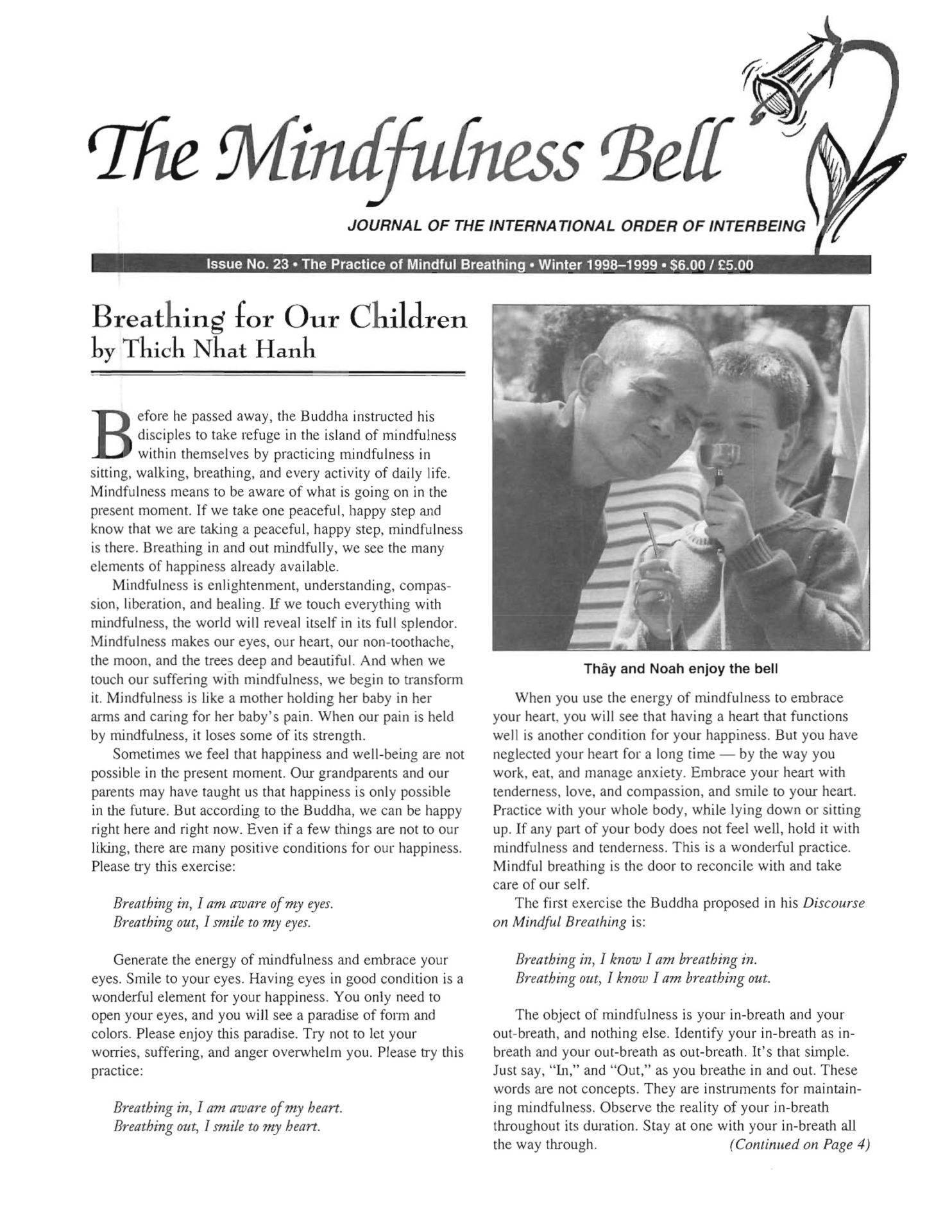By Joan Halifax in December 1998
The breath practice of Giving and Receiving develops our compassion and our ability to be present for our own suffering and the suffering of others. It is a practice of lovingkindness that opens up our whole being to the overwhelming presence of suffering and to our strength and willingness to transform suffering into peace and well-being. It is one of the richest and bravest practices we can do with people who are dying.
By Joan Halifax in December 1998
The breath practice of Giving and Receiving develops our compassion and our ability to be present for our own suffering and the suffering of others. It is a practice of lovingkindness that opens up our whole being to the overwhelming presence of suffering and to our strength and willingness to transform suffering into peace and well-being. It is one of the richest and bravest practices we can do with people who are dying.
We begin the practice with a heart committed to helping others, to being with suffering and dying. When we look deeply, we see that to help others, we must relate with kindness toward our own suffering. To deny our suffering is to close off our hearts to what we and others experience. If we touch our suffering with awareness and love, Giving and Receiving becomes a practice of transformation. To see the possibility that we and others can be free from suffering is to see our own vast, good, and tender heart.
When I sit with a dying person, I must see beyond individual suffering. I must look from a place in myself that includes suffering but is bigger than suffering. I must look from a heart so big it holds everything. Can I see her suffering and her great heart as well? Can I see his true nature, who he really is, deeper than the story?
The practice of Giving and Receiving asks us to invite in all of our suffering and the suffering of others, and let them break open our untrusting and protected heart. When my heart breaks open by being deeply touched by suffering, its tender spaciousness becomes the ground for the awakening of selfless mercy. With an open heart, we cannot help but send all of our love and kindness to one who is suffering.
To begin the practice, you want to feel relaxed and open. You can sit in meditation posture, relax in a chair, or lie down. Gently close your eyes and let your body and mind settle. You want your mind to be clear, calm, and spacious. If you feel agitated, angry, or afraid, breathe in whatever you are feeling, accepting it. On your exhalation, breathe out peacefulness and well-being. Clear your mind by bringing your awareness to what is agitating you and accepting it with kindness. Do this breath practice until you are calm and alert.
When you are calm and clear, you can begin the second stage of the practice. For some people who have never done this before, it will seem counter-intuitive, because it involves working with the breath in an unusual way.
You begin by breathing in hot, dark, heavy, polluted smoke-suffering. On your exhalation, you breathe out a breath that is light, cool, and fresh. Breathe not only through your nose, but through your whole body. On your in-breath, dark smoke enters every pore of your body. On your outbreath, coolness flows from every pore of your body. Stay in this rhythmic pattern of inhaling dark smoke and exhaling cool, light breath.
Next, visualize a metal sheath around your heart. This sheath is your self-importance, your selfishness, your self-cherishing, your self-pity, all the fearful contradictions that are difficult for you to accept. It is the fear that hardens to protect your heart. The practice invites you to break apart the metal sheath around your heart, to open your heart to its natural nonjudgmental state of warmth, kindness, and spaciousness. Visualize the metal sheath breaking apart when the in-breath of suffering touches it. When the heart opens, the smoke dissolves immediately, vanishing into the great spaciousness of your true and vast heart, and natural mercy arises. The quality of mercy in your vast heart allows you to be with suffering and at the same time, to see beneath the suffering. This is your awakened heart.
You have now touched the initial elements of the practice: calming and opening the mind, accomplishing the rhythm and texture of the breath practice, visualizing the metal sheath around your heart and the sheath breaking open, the spontaneous appearance of the vast heart of mercy, the disappearance of the smoke into space, and the out-breath of healing. Remember that you are doing this practice because you and others are suffering, and you wish with all your heart that all beings may be free from suffering.
You want to care, genuinely care. This wish cannot be general; it needs to be very specific, personal, and authentic. When the Tibetan teacher Trungpa Rinpoche practiced Giving and Receiving, he remembered a puppy he had seen when he was eight years old. The puppy was being stoned to death, and the people killing it were laughing. He would have done anything to relieve the dog of its suffering. Whenever he thought of the puppy, his heart broke open. The memory of this helpless little creature was a key that helped him practice with commitment, resolve, and love.
Bring to mind someone to whom you feel a deep connection, whether this being is dead or alive, someone who is suffering, not a being whose life is all grace, but someone who really has suffered and whom you wish to help be free from suffering. Let your whole being tum toward this one's suffering and wish that he or she may be healed. If this is difficult for you, tum toward your own situation. You are also suffering.
I ask you to breathe through your whole body your own suffering, your own alienation, or the suffering of your beloved as heavy, polluted, hot smoke. The instant that the in-breath of suffering touches the metal sheath of selfcenteredness around your heart, the sheath breaks apart and your heart opens to the suffering. The hot smoke of suffering instantly vanishes into the great space of your heart, and from this space arises an out-breath of mercy and healing. Send a deep, cool, healing breath to this other being or to yourself. Let the out-breath flow through every pore in your body. From the vastness of your open heart, breathe out mercy and love.
If you feel resistant, call yourself back to the practice. Remember that this practice can be done on every breath you take, every breath you give. Cultivate the details, the craft of this practice.
After you have practiced Giving and Receiving with yourself or one you love, let go of the image of that person. As you do, keep breathing in the dark smoke of universal suffering and breathing out healing. Then, let the visualization become particular again. Take your attention to the parent with whom you had the most difficulty-whether dead or alive, foster parent, or whoever raised you with whom you had the greatest difficulty. See them sitting before you.
Maintaining the rhythm of the hot, smoky in-breath and cool, light out-breath, consider how this one and you have suffered. For a minute, internally raise your eyes to this one and look at him or her. Let yourself slowly and mindfully examine the face and hair. Then, very simply gaze internally into the eyes of this parent with whom you have a problem. If this is difficult it may help to look at a mental photograph. See the wear on his face. See how her life has been full of disappointment and frustration. Maybe she was afraid. Maybe he was numb. See if you can allow yourself to be in touch with the difficulties of this parent. Perhaps you experience anger, disappointment, or heartbreak while looking at this parent. Let yourself feel whatever comes up. Imagine your parent as a five-year-old child. See his or her face fresh and open, full of anticipation. If it is difficult for you to see your parent this way, please notice the resistance that may be there. Resistance is all right. Breathe in the resistance, breathe out acceptance, spaciousness, warmth, and relief. If your parent is still alive, remember that he or she will die one day.
Remember your sincere wish at the beginning of this practice that the friend on whom you focused would be free of suffering. Breathe in blameless suffering as dark smoke. Remember your parent as you last saw him or her. Let the dark smoke of suffering break open the sheath of hardness around your heart. On your out-breath, send all of your strength, understanding, caring, and love to your parent. Give it away with an open heart so that this one may be healed, so that suffering will be transformed.
This practice can also be applied to your own life. Turn your heart and mind toward your own situation. Breathe in your suffering and let it break open the sheath around your heart. Let your own vast heart open to who you really are. Breathing out, send clarity and space to your whole being. Heal yourself. You have the power in you to come home to the vast and true nature of who you really are. If you are a Christian or Jew, you might say, "I want to come home to God." What separates you from God is the hardness around your heart, the fear in your heart. Breathe in the hot smoke of suffering from separation from God. Let it dissolve the hardness around your heart and disappear. What is left is love. All suffering disappears into the vastness. Breathing out, send a cool breath of radiant healing to yourself and come home to God. In your exhalation is the breath of spirit, the goodness of God bringing you home.
The practice of Giving and Receiving helps us get in touch with the obstacles that prevent us from understanding and caring. Through our own experience with suffering and the development of an atmosphere of openness toward it, we can begin to accept and be with the suffering of others in a more open, kind, and understanding way. Our difficult personal experiences are the bridge that leads us to compassion. We do not reject difficulties. Rather, we meet them exactly where they are. We cannot prevent suffering or death. We simply try to meet it, accept it, and find mercy in it.

Dharma teacher Joan Halifax, True Continuation, leads the Sangha at Upaya in Santa Fe, New Mexico. She is an anthropologist, leads retreats on death and dying and other issues, and has written a number of books. This article is excerpted from her forthcoming book, Being with Dying, to be published by Shambhala Publications in late 1999.

